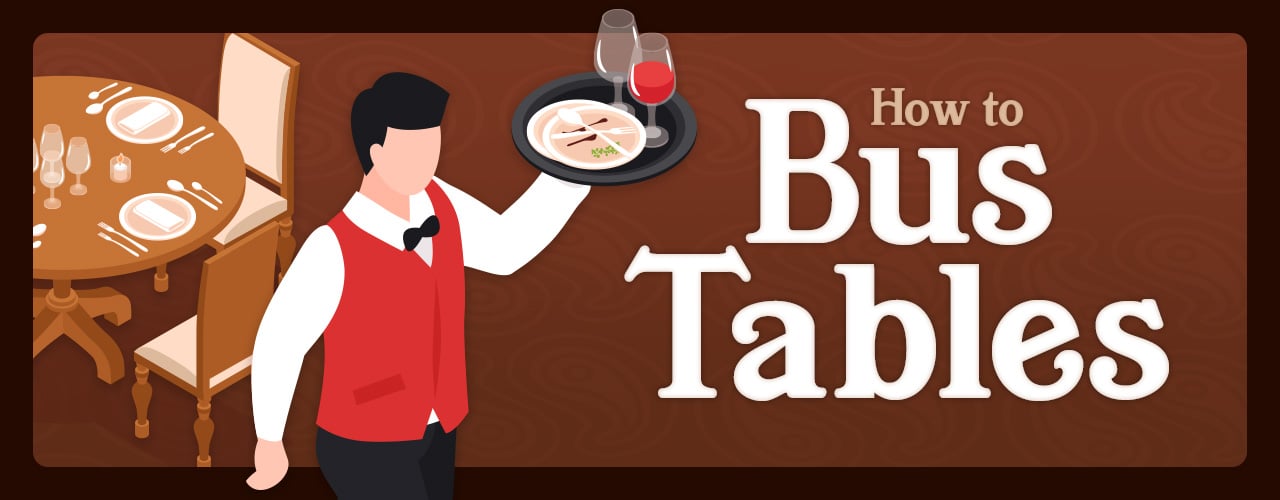While it is an often-overlooked area of restaurant management, table bussing directly impacts the overall dining experience. Table bussing is the process of clearing and cleaning tables after customers have finished their meals. While it may seem like a straightforward task, some key steps and techniques can make a significant difference in how efficiently and effectively your staff can bus tables. By implementing a systematic approach to bussing tables, you can streamline your operations and minimize downtime between customers. This will allow you to serve more guests and increase your overall revenue.
Shop All Bus Tubs and PansHow to Bus Tables Video
Watch the video below for a detailed walkthrough of how to bus tables!
What Is a Busser?

A busser is a restaurant employee who is responsible for clearing and resetting tables. They work closely with servers and other front-of-house staff to ensure tables are cleaned promptly, dishes are cleared away, and the dining area is presentable for the next round of guests. Bussers must be able to determine which items can be reused and which must be taken back to the dishwashing area. They may also be responsible for other tasks, such as refilling water glasses, restocking supplies, and assisting servers with various duties.
In some restaurants, bussers may also have the opportunity to interact with customers, providing them with a friendly and helpful presence throughout their dining experience. This can include answering questions, offering recommendations, or simply ensuring that guests feel welcome and attended to. They are the backbone of the front-of-house team, providing essential support to ensure that customers receive prompt and efficient service.
How to Bus Tables at a Restaurant

While bussing tables may seem like a straightforward job, it requires attention to detail, efficiency, and the ability to work well under pressure. Bussers must be able to prioritize tasks, anticipate the needs of both customers and staff, and work quickly to maintain a smooth flow of service. By following these steps, you can master the art of bussing tables and contribute to a positive dining experience for your customers.
- Memorize Table Layout - Before you start bussing tables, it's crucial to familiarize yourself with the dining room layout in your restaurant. Take a mental note of the table numbers and sections so you can easily find your way around the dining area. This will save you time and ensure that you don't miss any tables that need to be cleared. You should also memorize how to set a table, so you can work efficiently.
- Gather Bussing Supplies - Before you begin bussing tables, make sure you have all the essential supplies at hand. Grab a bus tub or a large tray, a bucket of sanitizer, and cleaning towels. These supplies will help you maintain cleanliness and organization throughout the bussing process.
- Be Willing to Help Pre-bus the Table - Pre-bussing involves removing any unnecessary items from the table that the guests no longer need. This includes empty bread baskets and used condiments. While pre-bussing is traditionally the server's job, if you notice a table has a lot of dirty dishes, take the initiative and help. Remember to handle these items with care and avoid making unnecessary noise or disruption.
- Top Off Beverages and Bring Extra Utensils - During your shift, check on guests' beverages. If a glass is nearly empty, offer to refill it. Always be prepared to bring extra utensils if needed. This proactive approach ensures that guests have everything they need for their dining experience.
- Clear the Table - Approach the table with a friendly smile and politely ask the guests if they have finished their meal. Once they confirm, start by removing any empty plates, bowls, or glasses from the table. Don't stack them too high, as it's challenging to carry them without causing any spills or accidents.
- Wipe Down the Table - Once the table is clear, use a clean towel to remove crumbs and food debris. Then use a sanitized towel to wipe the table down thoroughly. Look for any sticky spots or spills.
- Dry the Table - Don't leave the tables damp. This is a common problem; bussers clear, clean, and reset a table but leave it too wet for new guests to sit down and comfortably start their dining experience.
- Reset the Table - Once the table is clean and dry, place a fresh, folded napkin in the center of the table. Replace soiled or wrinkled tablecloths. Finally, set the table with clean utensils, glassware, and any necessary condiments or menus.
- Dispose of Waste - As you bus tables, you will encounter various types of waste, such as food scraps, used napkins, or empty containers. It is essential to dispose of these items properly. Empty any liquid waste into a sink or a designated drain. Use trash bins for solid waste as needed and aim to recycle as much as possible.
- Separate Dirty and Clean Items - To prevent cross-contamination, place dirty dishes in a designated area or bus tub in your washroom and never bring them near clean dishes.
Tips for Bussing Tables

When it comes to bussing tables, efficiency and attention to detail are key. Whether you're a seasoned professional or just starting in the foodservice industry, these tips will help you master the art of table bussing.
- Be Timely - As soon as a customer leaves a table, you should start the bussing process. This not only prevents any delays in seating new customers but also helps maintain a clean and inviting atmosphere for those waiting to be seated.
- Communicate with Host Staff - The host staff will tell you which tables need to be cleared and reset the fastest. Prioritize your bussing order according to their needs.
- Read Guest Behavior - Observing guest behavior is an essential skill that can help you determine when it's the right time to clear a table. Pay attention to guests who have finished their meals or are gathering their belongings.
- Use a Tray or Bus Tub - Carrying multiple items in your hands can be cumbersome and increases the chances of dropping something. Use a sturdy tray or bus tub to make your job easier.
- Clear the Table Methodically - Remove any empty dishes or glasses first. Then, gather all the remaining items, such as silverware, napkins, and condiments, and place them on a tray or bus tub. This way, you can clear the table in one go, minimizing trips back and forth.
- Protect Glassware - While bussing tables, prevent mechanical shock to your glassware by never stacking your glassware or filling glasses with flatware. Each time glassware comes in contact with another object, it produces a mechanical shock which induces invisible abrasions that weaken the glass and make it more susceptible to breakage.
- Stack Dishes Properly - Stack the largest plates at the bottom and work your way up to smaller ones. This prevents them from toppling over and keeps your hands free to carry other items.
- Only Bring Bus Bins to Empty Tables - Bus bins are unsightly and you shouldn’t bring them to a table where guests are present.
- Clean Your Bus Bins - Because you’re using them to clear dishes and clean tables, bus bins become dirty. Clean your bus bin a few times during each shift.
- Change Dirty Aprons - Keep extra busser aprons on hand so you can change a stained or dirty apron during your shift. Bussers must appear clean and tidy even though they’re doing a messy job because they work on the dining room floor.
- Replace Cleaning Towels Regularly - Bussers will go through many cleaning towels. Never use a soiled towel in front of guests. Once a towel is soiled with spilled coffee, juice, or sauce, retire that towel and get a new one.
- Schedule Sanitizer Pail Refills - You must make sure your sanitizer pails of water are fresh. To meet ServSafe standards, you must change sanitizer solution buckets every 2-4 hours. Have a set schedule to ensure you’re changing your sanitizer regularly. If your sanitizing water becomes visibly dirty before the refresh schedule dictates, then change it.
How Old Do You Have to Be to Bus Tables?
Bussing tables is an entry-level job, making it an ideal restaurant position for high school and college students. The specific age requirements for table bussers will depend on the state guidelines for legal working age in your area. If you're looking to hire a table busser, check with your state's labor laws to determine the minimum age requirement. Not just for young job seekers, bussing tables is a great way for anyone to break into the foodservice industry. It provides valuable experience and growth opportunities.
Bussing tables is not just about clearing dishes and wiping surfaces. It creates a clean and welcoming environment for your customers and enhances their overall dining experience. A well-bussed table not only improves the efficiency of your establishment but also leaves a positive impression on your guests, critical for earning positive reviews on Yelp.



